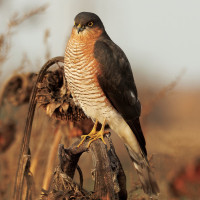Opis
De viewpoint of Gradina del Poggio in Monte Cònero Regional Park is a special place. Every year, at the arrival of spring, the same spectacle is repeated: the passage of thousands of birds of prey and other soaring birds on Mount Conero. The headland located within the park of the same name, is in fact one of the main landmarks for birds of prey that, from wintering areas, migrate to the European nesting territories. The Conero is considered the second most important migration site in Italy, after the Strait of Messina, for the spring migration of birds of prey.
The Park is ranked in the national top ten in Italy as a site for birdwatching. During the months of April and May you can sometimes admire more than 1000 birds of prey in a single day. You can see many Trzmielojad, gadożer and błotniak stawowy, but also sokół skalny, kobczyk, kobuz. Besides raptors also żuraw, bocian czarny and bocian biały are sometimes seen here on passage.
Szczegóły
Dostęp
You can park at the Gradina del Poggio (see the P on the map and click on the P to go there directly). You can combine a visit to the observation viewpoint with many walks in the Monte Cònero Regional Park (see below).
Teren i siedlisko
Góry , ŁąkaWarunki
Górzysty , Otwarty krajobrazTrasa dookoła
TakCzy luneta będzie przydatna ?
Może być przydatnaUdany sezon obserwacyjny
Wiosna , Lato , JesieńNajlepszy czas na wizytę
WiosnaTrasa
Droga utwardzonaPoziom trudności szlaku pieszego
ŁatwyDostępne
PieszoCzatownia/platforma obserwacyjna
NieDodatkowe informacje
The Monte Cònero Regional Park is a protected area where you can walk in the 18 trails that wind through the woods. The area includes a stretch of high coastline, as well as a wide hilly interior, characterized by panoramic views. Its eastern slopes on the sea are made up of limestone cliffs and in the rest it is dominated by vast Mediterranean formations and mixed woods. See the link below to download walking trails.


